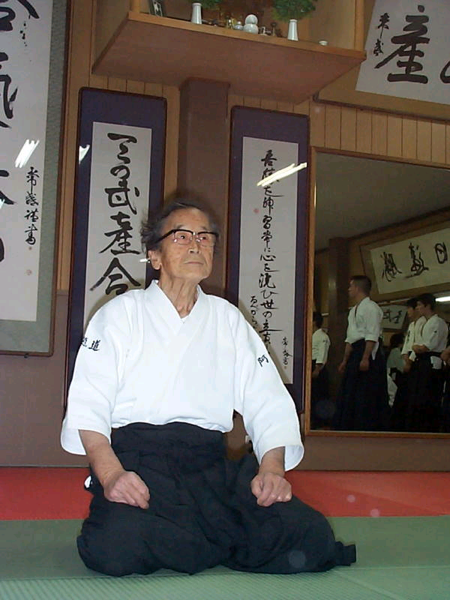
Seiseki Abe (阿部醒石), 1915- 2011
Amenotakemusu Juku Aikido Dojo (天之武産塾合気道道場)
Seiseki Abe was born in Osaka, Japan. A teacher of Japanese calligraphy, he was also a student of Misogi under Dr. Kenzo Futaki, who had trained under Aikido Founder Morihei Ueshiba. He began training in Aikido after encountering the Founder in Osaka in 1952 and then began teaching him calligraphy a few years later, thereby occupying a unique position as both a student and a teacher of Morihei Ueshiba. He was one of a small number of people to be awarded tenth dan directly by O-Sensei, although the Aikikai only officially recognizes him as an eighth dan.
In this short essay, published in the Rikuryo Alumni Association “Visiting our Teachers” series in 1988, Abe Sensei recalls his first encounter with Aikido Founder Morihei Ueshiba.
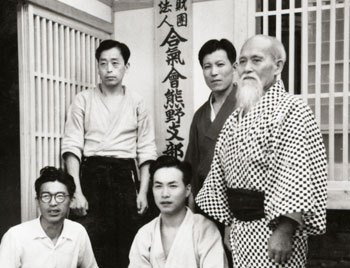
Seiseki Abe, standing far left, with Morihei Ueshiba
Kumano Juku, 1954
Meeting Morihei Ueshiba O-Sensei
by Seiseki Abe
In Showa year 27 (1952), when I had just started working in Kitano, Bansen Tanaka-san (田中万川 – first chairman of the Osaka Aikikai, passed away in 1988) established his dojo, saying “I want to spread Aikido in Osaka”. I knew nothing about that, but the day after the opening I happened to be passing by the front of the dojo and noticed a nameplate saying “Morihei Ueshiba”.
When I opened the entranceway and asked “Is Ueshiba Sensei here?” Bansen-san was there and said “Yes, we had the dojo opening yesterday”. I knew Tanaka-san, but I didn’t know that he did Aikido.
After a short time O-Sensei came out and we met for the first time. He said “You’re a student of Futaki Sensei (*1)”, and then right away he said “come in, come in”. The things that O-Sensei talked about at that time were difficult to understand. He spoke of things far and above “Chinkon Kishin” (*2). I listened to what he said respectfully…and then he said “You, come starting tomorrow!”.
(*1) Translator’s note (Kenzo Futaki): Dr. Kenzo Futaki was a medical doctor and a pre-war student of Aikido Founder Morihei Ueshiba, an advocate of a diet of unrefined brown rice, and the founder of the Misogi Renseikei (禊の練成会 – Misogi Training Society) whose practices would influence Morihei Ueshiba’s own training.
Dr. Kenzo Futaki’s Ten more and Ten Less Rules for Health
- Eat less, chew more.
- Right less, walk more.
- Wear less, wash more.
- Worry less, work more.
- Idle less, learn more.
- Speak less, listen more.
- Get angry less, laugh more.
- Say less, do more.
- Take less, give more.
- Blame less, praise more.
二木謙三博士の十少十多の健康訓
- 食うこと少なくして、噛むことを多くせよ。
- 乗ること少なくして、歩くことを多くせよ。
- 着ること少なくして、浴びることを多くせよ。
- 悶ゆること少なくして、働くことを多くせよ。
- 怠けること少なくして、学ぶことを多くせよ。
- 語ること少なくして、聞くことを多くせよ。
- 怒ること少なくして、笑うことを多くせよ。
- 言うこと少なくして、行うことを多くせよ。
- 取ること少なくして、与えることを多くせよ。
- 責めること少なくして、誉めることを多くせよ。
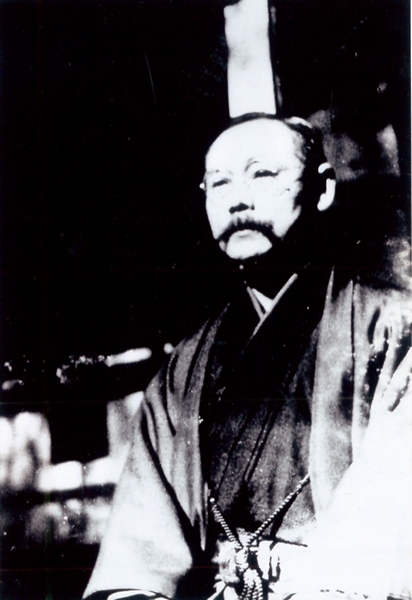 Dr. Kenzo Futaki
Dr. Kenzo Futaki
(*2) Translator’s note (“Chinkon Kishin”): 鎮魂帰神 – “calm the spirit and return to the source”, a kind of ritual spirit possession practiced by Morihei Ueshiba.
From Transmission, Inheritance, Emulation 25, by Peter Goldsbury
Onisaburo Deguchi’s Kamigakari:
From Chinkon [鎮魂] and Kishin [帰神] to Chinkon Kishin [鎮魂帰神]
As stated above, Kamigakari is usually translated as spirit possession, possession by a tsukimono [憑き物], which need not necessarily be a deity. However, Deguchi Onisaburo never used this term, preferring instead expressions like yuusai [幽斎] and, especially, chinkon kishin. Onisaburo Deguchi almost certainly borrowed the practice of chinkon kishin from his teachers, Honda Chikaatsu and Nagasawa Katsutate. Honda regarded chinkon and kishin as two distinct activities, but Onisaburo Deguchi combined them into one practice. We need to discuss the provenance of chinkon and kishin in some detail and the following account is based on Birgit Staemmler’s detailed analysis in her doctoral research. A clear advantage of considering Staemmler’s account is that she has no discussion either of Morihei Ueshiba or of aikido and so there is no trace of the ‘washback’ thinking that tends to occur in biographies of Ueshiba. Her only reference to Morihei Ueshiba is to state that he, too, practiced chinkon kishin, along with members of the armed forces and intellectuals, when he moved to Ayabe in 1920.
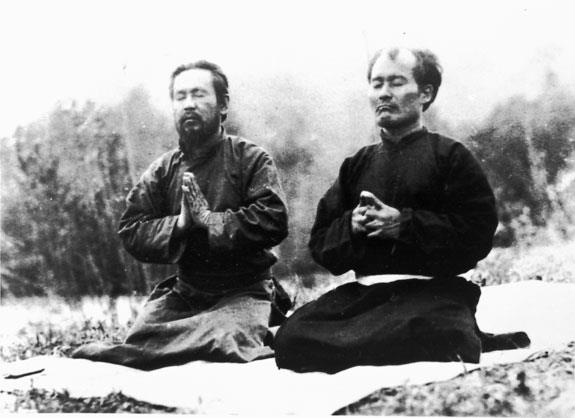 Omoto Priest Masumi Matsumura and Morihei Ueshiba
Omoto Priest Masumi Matsumura and Morihei Ueshiba
Chinkon Kishin practice in Mongolia, 1924
I was really in a bind. I was a student of Futaki Sensei, and Ueshiba O-Sensei, who I should say was the Founder of Aikido, had given me permission to become a student. In those days one was not able to become a student in multiple schools. And this was a person who wouldn’t teach you unless you had two introductions! (laughing)
During the war Ueshiba Sensei taught Aikido at the Military Police School (the Rikugun Nakano Gakko) and couldn’t come out of it as a civilian. I don’t know if he was Class A or Class B, but he was named as a war criminal after the war was lost and the M.P.’s came in a jeep to arrest him.
*Translator’s Note: the Military Police (Kempeitai / 憲兵隊) were the secret police for the Imperial Japanese Army, the Japanese equivalent of the German Gestapo. The Rikugun Nakano Gakko (陸軍中野学校), the “Nakano Spy School” was the primary training center for the Imperial Japanese Army’s intelligence division.
It happened that at the time Ueshiba Sensei had a high fever and was in bed sleeping…but the foreigners were wonderful – instead of taking the stance “no matter what, he will be taken into custody immediately” they said “well, he’s sick and I guess that there’s no way that he can run away”, and they started with a search of the house (if it had been the Japanese army…no matter how sick he was I think that they would have taken him off to Sugamo Prison).
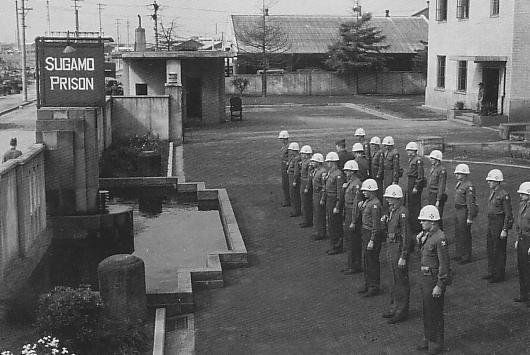 Guards at attention at Sugamo Prison, 1948
Guards at attention at Sugamo Prison, 1948
When they did that, all of his writings turned out to be on pacifism (平和主義). Whatever writings they looked at they were all about advocating for peace. Then they understood “certainly he was employed as a budo instructor by the military, but Ueshiba is the very epitome of a pacifist”…and there he became the first of the war criminals to be released. In the end, he was never put into Sugamo Prison and was able to live life as a farmer.
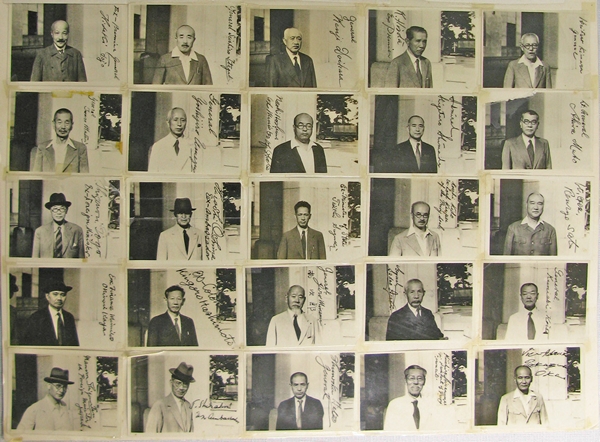 Signed photographs taken at Sugamo Prison
Signed photographs taken at Sugamo Prison
this group includes a number of the Morihei Ueshiba’s associates
Morihei Ueshiba’s close friend Shumei Okawa declined to be photographed
(top row, left to right): “Ex-Premier General Hideki Tojo” (hanged 1948), “General Seishiro Itagaki” (hanged 1948), “General Kenji Doihara” (hanged 1948), “Ex-Premier K. Hirota” (hanged 1948), “General Heitaro Kimura” (hanged 1948), (2nd row) “General Iwane Matsui” (hanged 1948), “General Yoshijiro Umezu” (life; died in prison 1949), “Ex Minister of State Naoki Hoshino” (life; paroled 1958), “Admiral Shigetaro Shimada” (life; paroled 1955), “Lt. General Akira Muto” (hanged 1948), (3rd row) “Ex-Foreign Minister Shigenori Togo” (20 years, died in prison 1950), “Ex-Ambassador Hiroshi Oshima” (life; paroled 1955), “Ex-Minister of State Teiichi Suzuki” (life; paroled 1955), “Ex-Lord Keeper of the Privy Seal Koichi Kido” (life; paroled 1953), “Lt. Gen. Kenryo Sato” (life; paroled 1956), (4th row) “Ex-Finance Minister Okinori Kaya” (20 years; paroled 1955), “Ex-Colonel Kingoro Hashimoto” (life; paroled 1955), “General Jiro Minami [also signed in Japanese]” (life; paroled 1954), “General Sadao Araki” (life; paroled 1955), “General Kuniaki Koiso” (life; died in prison 1950), (bottom row) “Ex-Foreign Minister of Japan Mamoru Shigemitsu” (sentenced to seven years; paroled 1950), “Ex-Ambassador T. Shiratori” (sentenced to life; died in prison 1949), “General Shunroku Hata” (life; paroled 1955), “Ex-President of Privy Council Kiichiro Hiranuma (life; paroled 1952), and “Vice Admiral Takazumi Oka” (life; paroled 1954).
*Translator’s Note – on Morihei Ueshiba and war crimes:
from Transmission, Inheritance, Emulation 6, by Peter Goldsbury
O Sensei as a War Criminal
The principal evidence for this from the world of aikido is to be found in Aikido Jinsei by Gozo Shioda. The statement appears on p. 166, in a section recounting his meeting with O Sensei in Iwama in Showa 21 (1946). For those who can read Japanese, here is the text:
Sensei wa touji Ibaragi-ken no Iwama ni insei shi, moppara noukou ni shitashinde oraremashita. Senji-chuu Sensei wa Kyoto no Butokukai no koumon wo sarete ita kankei ue, MacArthur no jirei ni yori G-go wo tekiyou sarete, koushoku tsuihou ni nari, Zaidan Houjin Aikikai mo kaisan no ukime atte oraremashita. Sono tame Aiki-en to iu namae no nouen wo hiraite mainichi noukou wo sareru katawara, doukou no mono wo atsume aikidou wo shidou sarete imashita.
A similar statement can be found in an interview with Gozo Shioda conducted by Stanley Pranin. The latest version of this interview can be found on pp. 185-186 of Vol I of Morihei Ueshiba to Aikido, published in 2006. Here is an English translation:
Pranin: After the war O Sensei also had a very difficult time.
Shioda: The fact that Ueshiba Sensei was an adviser to the Butokukai in Kyoto was not good. Sensei was implicated in Class G war crimes / as a Class G war criminal. Ueshiba Sensei’s foundation was cancelled and his activities were forbidden. Thus Sensei confined himself in Iwama and since he could no longer practice budo, he created the Aiki-Farm and engaged in farming. It was a precarious existence.
There has been some discussion on the Internet about such war crimes and questions raised about the truth of Shioda’s statements. First, a description of Class G ‘war crimes’ is in order.
The source is SCAPIN (Supreme Commander Allied Powers Index) 550, of January 4, 1946, which ordered the removal and exclusion from public office of Japan’s wartime leaders. Broad categories delineated those who were to be purged. (A) Indicted war criminals; (B) All career military officers; (C) Leaders of the Imperial Rule Assistance Association and affiliated organizations; (D) Leaders and influential members of ultranationalist, secret and terrorist organizations; (E) Executives of companies involved in Japanese expansion; (F) Governors of occupied territories; (G) Initially broadly based and unspecified “additional militarists and ultranationalists”.
The above classification can be found in Hans Baerwald’s “The Occupation of Japan as an Exercise in ‘Regime Change’: Reflections after Fifty Years by a Participant”, JPRI (Japan Policy Research Institute) Occasional Papers 29, p. 3. Baerwold adds the rueful comment that:
Moreover, all SCAP staff sections had to rely on their counterparts in the Japanese bureaucracy for basic data and assistance in drafting reforms. This necessity allowed the Japanese officials to protect themselves and promote their own agenda by influencing SCAP officials. It was an early variant of using gaiatsu (foreign pressure) to their own advantage. I was an unwitting participant in the game while drafting purge criteria involving members of the Dai Nippon Butokukai, the Great Japan Military Virtue Society.
It is interesting that Baerwold was involved in drafting purge criteria for the Dai Nippon Butokukai, which included aikido from 1942 onwards. The categories listed in SCAPIN 550 need to be read in conjunction with SCAPIN 548, which added the Dai Nippon Butokukai, with all its affiliated organizations, to the list of organizations proscribed by SCAP.
Shioda’s allegations are strongly denied by Kisshomaru Ueshiba on pp. 83-84 of Aikido Ichiro. Kisshomaru also quotes the relevant passage from Aikido Jinsei (quoted in Japanese above) and rebuts the allegations one by one. Thus, O Sensei was not an adviser to the Butokukai during the war; he was not subject to any banning order from SCAP; and the Aikikai was never proscribed.
I have not found any evidence outside aikido to support Gozo Shioda’s statements, but it is possible that Ueshiba is listed somewhere in the SCAP archives. However, the SCAP order issued in January 1946 initiated a search process that took a year to complete and the actual purge orders were not issued until 1947, when Shioda had already visited O Sensei in Iwama (in July 1946: see the interview, above). Nevertheless, given the influential people he knew, including a number of ultranationalist military officers who also trained at the Kobukan Dojo in the 1930s, it is possible that Shioda had such information and that O Sensei also knew he was under suspicion. However, even if he had come to the attention of SCAP, the only content of O Sensei’s ‘criminal’ activity is that he practiced a Japanese martial art. This might explain why he kept quiet in Iwama at least until around 1950, when the purge orders were lifted. SCAP had already turned its attention to the Korean War and liberated all the war criminals. Moreover, it was as early as 1948 that the Zaidan Houjin Aikikai, with its headquarters in Iwama, was approved by the Japanese education ministry as the postwar version of the Zaidan Houjin Kobukai. This appears to have been done by Kisshomaru Ueshiba, with the support of people like Kinya Fujita and Katsuzo Nishi, but appears to have been done very quietly, to avoid annoying SCAP.
(NOTE. I have benefited very much by a recent discussion about Class G war criminals on the Aikido Journal website and from private correspondence with some of the participants in this discussion.)

Ueshiba Sensei’s calligraphy will remain in perpetuity,
forever a shining treasure of the world.
From Showa year 30 until he passed away in Showa year 44 (1955-1969), this Ueshiba Sensei stayed in my home for one week to ten days of each month. That is to say, the relationship between master and student was joined. The severe bushido type teacher student relationship of past times. This strictness was not forced upon me, it was the “way” of an uchi-deshi serving their master…that was how I regarded it. Without going that far one cannot grasp the essence of their master. Twenty-four hours per day, every day, under the same roof, what I learned was not just technique, it was that person’s way of living…that is “kokyu-ho”.
By his side for twenty-four hours per day training my Ki. O-sensei’s moods, they were all communicated through his living. That is to say, I was connected to O-Sensei’s life. This was incredible.
For example, when I made tea, I would have to judge how thirsty Sensei was and adjust the temperature accordingly, and when I heated his bath I would have to check the water temperature by scooping water out of the bathtub with a dipper rather than putting my hand directly into the water. If I were to put my hand directly in the water then a small amount of the oils on my hand would spread into the water. Sensei would know that. That’s why they say “The way of the disciple is harsh”.
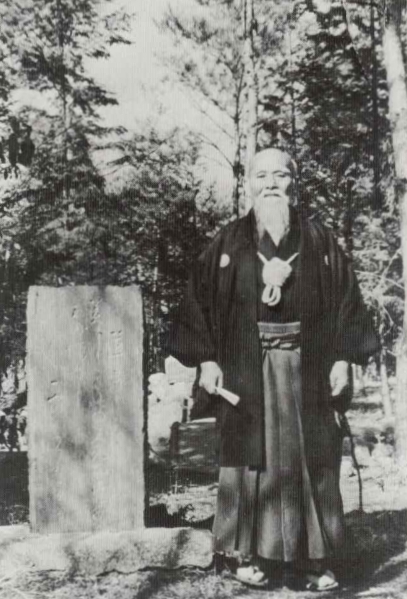
Stone monument at the Aiki Jinja in Iwama
The inscribed Doka is by Aikido Founder Morihei Ueshiba
calligraphy by Seiseki Abe
(more in “Three Doka and the Aiki O-Kami“)
「美しき
この天地の御姿は
主の作りし
一家なりけり」
“So beautiful,
the form of this Heaven and Earth
created by Su-
to be a member of the one family”
And then I trained that thing called “Ki”. That “kokyu” is shared exactly with calligraphy,
One day Ueshiba Sensei said “That looks interesting, I’ll try it too.” and started drawing calligraphy. I’m sure that he wrote “Aiki”. From that day the comical reverse drama of “the disciple teaches the master…” began. Normally, something like this would be unthinkable…it made me extremely nervous.
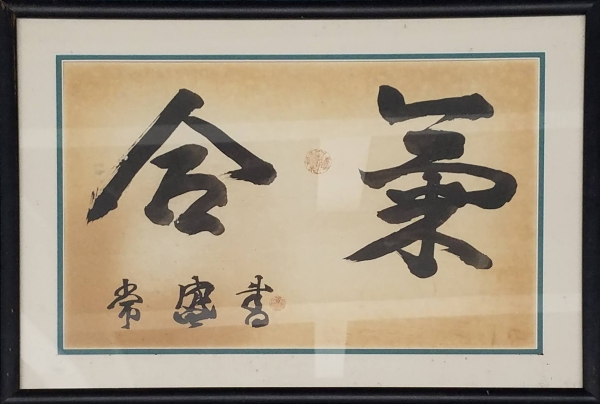 “Aiki” calligraphy by Morihei Ueshiba
“Aiki” calligraphy by Morihei Ueshiba
from the Waialae Avenue dojo in Honolulu, Hawaii
First, without giving him a pattern, I would draw an example and show it to him. Sensei would stare at it and then say something like “so that’s how you draw it”, and then draw it himself.
Intently…concentrating the entirety of himself in the tip of the brush, “Ki” would enter through the ink. For that reason, one can feel an incredible amount of “Ki” in Ueshiba Sensei’s works. Just turning one’s face to the calligraphy and putting palms together, the “Ki” leaps off at you. Foreigners who can’t read the characters seem to be even better at directly receiving that Ki.
And then, when he drew he would draw in a single burst. He would not think of things like his breathing. For that reason, the most difficult thing was for him to write his name on the work at the end…clearly marking that place and position. There was only one place, pointing to that place…there is a place in the “Ki” of this single moment that leads to the “Ki” in Aiki, that is where the Ki of A-un (阿吽) exists.
*Translator’s Note: “A-un” is the Japanese transliteration of the first and last letters of the sanskrit alphabet and represent, in Japanese Shingon Mikkyo, the beginning and end of the universe, Yin and Yang.
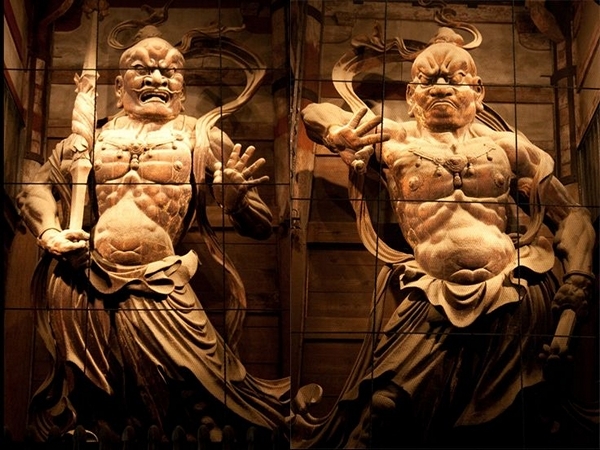
The A-un statues at Todaiji in Nara, Japan
More in “Aiki, Iki, Kokyu, Heng-Ha and Aun” – Part 1 | Part 2
From the Rikuryo Alumni Association “Visiting our Teachers” series, 1998
Published by: Christopher Li – Honolulu, HI


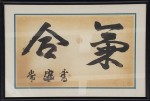
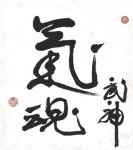
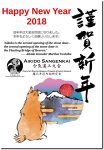

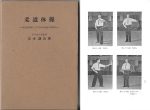
Seiseki Abe also blessed Haruo Matsuoka’s second dojo with an auspicious name. Taken from the concept of Morihei Ueshiba’s most famous quote —